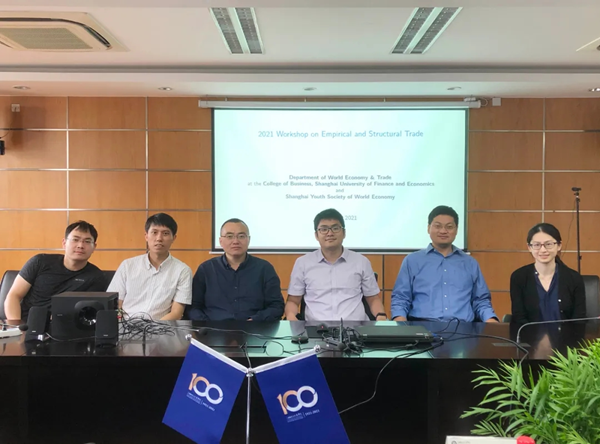
The 2021 Forum on Empirical and Quantitative Research of international trade was successfully held. It was jointly organized by the innovation team of International Trade Theory and Policy of the College of Business (COB)of Shanghai University of Finance and Economics (SUFE), the School of Economics of Peking University, and the Youth Committee of the Shanghai World Economics Society. They are committed to establishing a professional international exchange platform for empirical and quantitative frontier research in the field of international trade. The 2021 Forum on Empirical and Quantitative Research of International Trade invited Professor Costas Arkolakis from Yale University to deliver a keynote speech and 11 young scholars on international trade from Asia, Europe and North America to share their latest research findings.
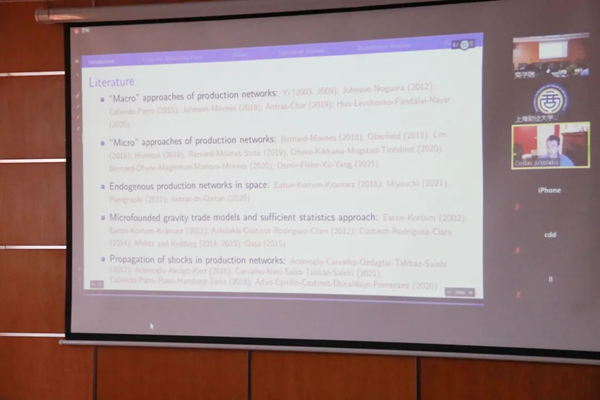
The first segment on 15 May began with a keynote address entitled “Spatial Production Networks” by Professor Costas Arkolakis from Yale University. The paper examined how endogenous production networks among firms affect the spatial distribution of macro-policy shocks. For this purpose, the report built a microscopic model of endogenous production networks among firms through a “search-match” process, and embeds this model into a spatial general equilibrium model. Thus, the framework not only conformed to the typical characteristics of bilateral relations among enterprises at the enterprises’ micro-data level, but also sumed up the macroscopic characteristics like a gravitational equation in the overall data process. The study employed data from Chile’s inter-firm production networks to estimate key parameters in the latest quantitative framework and to quantify the impact of international trade with China. The results show that the heterogeneous production network data among enterprises retain an immense significance to assess the spatial distribution of macro-impact that traditionally estimates the impacts based on aggregate data are biased as they ignore endogenous production network built with the “search-match” process.
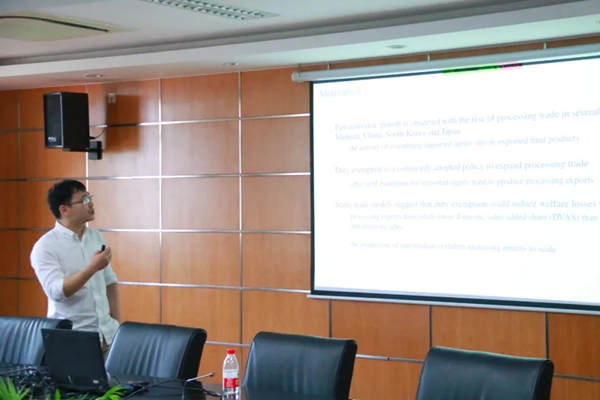
This was followed by a lecture entitled “Processing Trade and International Idea Diffusion” by Deng Jianpeng, Assistant Professor in the COB of SUFE. To begin , the paper theoretically discussed the short-term welfare loss and long-term welfare gains caused by processing trade policy. In the short term, the fact that processing trade exempts processing exports from import tariffs of intermediate goods lead processing producers to choose production technologies that favor imported intermediate goods. It in this way squeezes the market share of domestic intermediate goods, leading to domestic intermediary goods production shrinkage. In the final analysis, the processing trade policy will expand the share of imported intermediary goods with innovative technology, which will have technology spillover with regard to the domestic intermediate goods production. The study used China’s 2000-2007 data to quantify the theoretical short-term welfare losses and long-term welfare gains from processing trade policies, pointing out the key for developing countries to benefit from the processing trade lies in whether intermediary product imports can produce enough technology spillover.

The third speaker at the first forum was Professor Li Zhiyuan from Fudan University. The paper was entitled “Branding Dynamics and Trade Liberalization”. The study creatively combined Chinese companies’ trademark applications in diverse countries around the world with their trade and production data. This presentation, using data on trademark applications at the corporate level, described the efforts made by enterprises to enter the target market in terms of brand and marketing. The study then used Arkolakis’s (2010) general equilibrium trade model of firms’ endogenous marketing inputs to conclude a country’s lower import tariffs that would lead its firms to apply for increased trademarks in international markets. The paper managed Chinese data from 2000 to 2006 to validates its theoretical predictions.
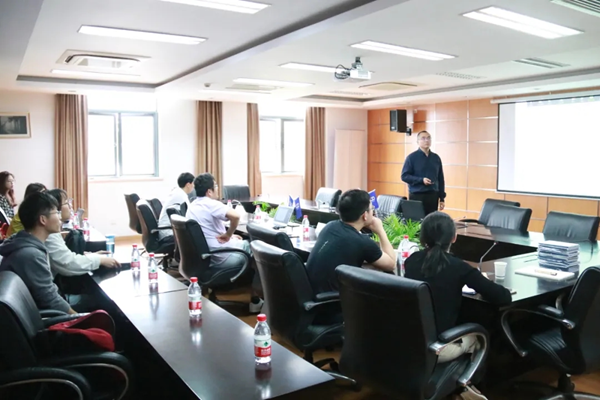
The second part of the Forum on May 15 started with the report entitled “Globalization and the Long-Run Belief-Scarring Effects of COVID-19” by Han Yang from Taiwan Central Academia. One factor that has not received much attention in the current debate about the lasting impact of the coronavirus that will change expectations and beliefs. These changes will not disappear as soon as the epidemic goes away, but might be continued over the long-term effects. This study focused on the labor force’s expectation of the labor market in various industries, and constructs a multi-country and multi-sector general equilibrium model in which the labor force forms its judgment of the market based on Bayesian learning to determine the labor supply chain. The model took into account of the dynamic changes of coronavirus, the various effects of remote operating conditions in different industries of many countries due to the differences in blockade and isolation policies. The study, which adopted a calibrated model to simulate global economic dynamics two decades after the coronavirus outbreak, found that the impact of the outbreak on people’s beliefs and expectations would continue to hamper global economic recovery.
Then Farid Farrokhi, Assistant Professor at Purdue University, delivered a speech entitled “Trade, firm-allocation, and Optimal Climate Policy”. In the context of global “Carbon neutrality” efforts, how to apply trade policy to overcome the challenge of “Free Rider” among countries to reduce carbon emissions, which has turned out to represent a key issue with both theoretical and policy implications. The study built a multi-country, multi-sector general equilibrium model that considers how countries use tariffs, industrial subsidies, and “Carbon taxes” to achieve individual and global optimality. The result shows that there is much room for cooperation among the world’s major economies in using various policies to achieve a balance between economic development and carbon emissions.
The third speaker of the second forum was Yuan Zi, Assistant Professor from the University of Oslo in Norway. The topic was “Sparse Production Networks”. In recent years, a good number of studies have focused on inter-firm trade and production networks, mostly using micro-data from inter-firm trade and production networks estimating the quantitative model on the microscopic basis of “search-match”. Yuan Zi’s research points out that a series of typical facts, supporting the complex “search-match” model to be replicated by a simple bilateral random matching model. Therefore, the micro-typical facts emphasized existing studies, which cannot support the standard inter-firm “search-match” model. The study further discussed what fairly typical facts can “falsify” a simple two-sided random matching model.
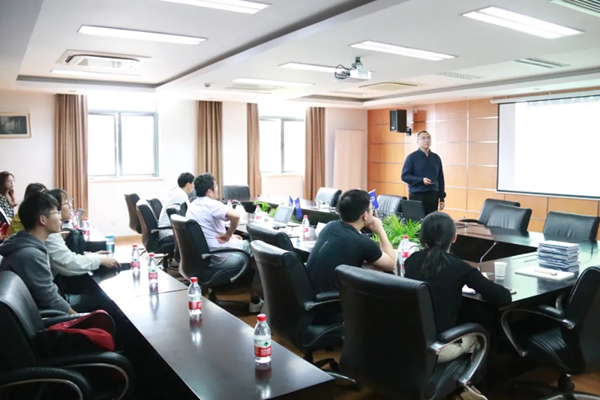
On May 16, the third forum started with a report “Trade Uncertainty and Firm pollution” by Professor Fan Haichao from Fudan University. The study focused on the impact of the decline in trade policy uncertainty on the output and pollution levels of enterprises following China’s entrance to the WTO in 2001. It made special attention monitoring the heterogeneous change of enterprises sewage level brought by the policy of “Two control zone” using China’s data from 2000 to 2006, the study found that productivity growth of enterprises made by the reduction of trade policy uncertainty having little difference within and outside the “Two control zone”. The study further confirmed that the decrease in pollution intensity was due to the reduction of fossil fuel as well as sulfur content uses, and the improvement to pollution treatment capacity.
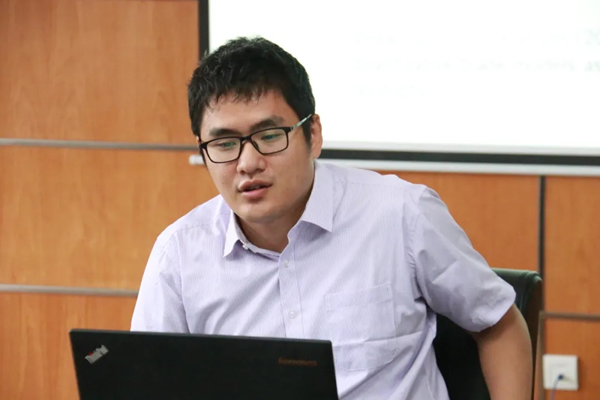
Belatedly, Wang Zi, Assistant Professor at COB of SUFE, offered a presentation entitled “Armington Elasticities and the Third-Country Effects of Trade Conflicts”. This study established a general equilibrium model that allows the substitution elasticity of domestic and imported products to be rarely than that of imports from diverse countries. It theoretically proved a tariff war on imports from one country would lead mainly to an increase imports from third countries rather than to increase domestic employment. The structural gravity model was used to demonstrate the systematic differences in substitution elasticity and quantify the welfare effects of trade frictions between China and the United States. The results show that the standard quantitative model critically underestimates the impact of the Sino-US Trade War on the third countries because it disregards the difference of substitution elasticity.
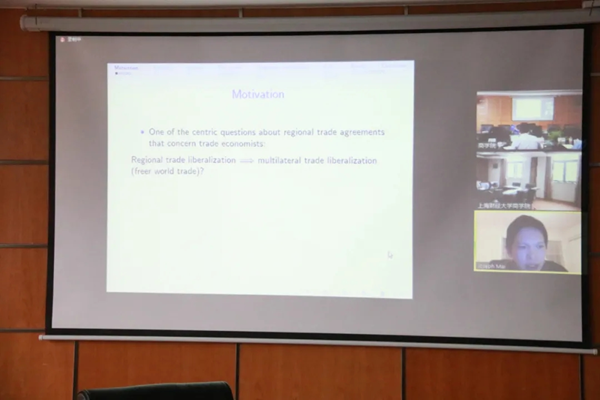
The last speaker of the third sub-forum was Jiacong Mai, Associate Professor fromCOB of SUFE. The study was entitled “Trade Policy Coordination in Free Trade Areas”. The paper focused on the trade policy (external tariff) motivation of RTA-member countries to non-member countries. He firstly pointed out that the signing of RTA possessed two opposite effects on the external tariff. The member countries have incentives to reduce external tariffs to reduce the import distortions caused by intraregional tariff concessions. Secondly, after a regional trade agreement has been reached, member countries will take into account of the interests of other member states to impose their external tariffs. The study afterword employed data from regional trade agreements, combined with measurements of political linkages among countries to test two theoretical motivations.
The fourth sub-forum entitled“Comparative Advantage, Competition, and Firm heterogeneity” held on May 16, began with the presentation by Huang Hanwei, Assistant Professor at the City University of Hong Kong. This presentation focused on how firm heterogeneity shapes comparative advantage among countries. Based on the micro-data of Chinese enterprises, this study found that the export status, the range of export products and the distribution of export products are all related to the labor intensity system. For this purpose, the study constructed a bi-national, multi-sector model with firm heterogeneity and endogenous addition rates, which proved that firms in relatively disadvantaged industries will face intense competition in export markets, and this competitive effect will weaken the natural comparative advantage. In addition, this paper quantified the impact of firm heterogeneity on the measure of comparative advantage.
After that, Jingting Fan, Assistant Professor at Pennsylvania State University, offered “High-Skill Immigration, Offshoring R & D, and Firm Dynamics”. The study uses Danish firm-level R & D and employment data to characterize the typical facts of outsourcing R & D activities, and constructs a dynamic model of firms’ external innovation and employment of highly skilled immigrants. The model and simulations estimates that outsourcing R & D increases productivity while employing high-skilled immigrants assists firms in outsourcing R & D.
The last speaker at the Fourth Forum was Tian Yuan, Assistant Professor from the University of Nottingham, and the report was entitled “Trade-Induced Urbanization and the Making of Modern Agriculture”. The study looked at whether free trade induced rural-urban migration had led to agricultural modernization in China. Using a Shift-share design based on data collected from fixed observation points in rural Chinese households, the study found that China’s trade liberalization was driven labor migration from the agricultural sector to the manufacturing sector. This was expanding the average cultivated land area of agricultural producers, improving the level of mechanized agriculture, and activating the circulation market of contracted land, which reduces the degree of mistaken judgment of cultivated land. These factors have led to increasing agricultural productivity in China.
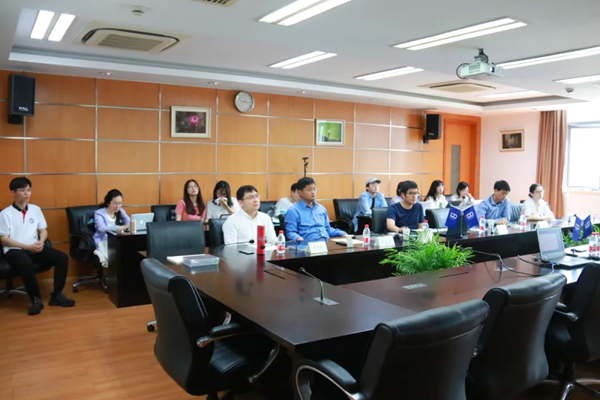
The Forum of Empirical and Quantitative Research on International Trade takes the idea of specialty, frontier and internationality trying to establish a platform for free exchange of academic ideas among international trade scholars, particularly among young scholars. The 2021 forum was co-sponsored by COB ofSUFE , the School of Economics of Peking University, and the Youth Committee of the Shanghai World Economic Society. The eventattracted a large number of experts and scholars from renowned universities at home and abroad including Peking University, Tsinghua University and Yale University, withmore than 100 participants for each sub-forum. In the future, we aim to hold the forum once a year to enhance the quality of conference papers and discussions, making the forum a truly international and first-class platform for idea exchanges on international trade.

